Goal 1: Improve Canopy Quality
Improve quality and safety of the urban forest to ensure sustainability.
Tallahassee’s urban forest is made up of a preponderance of short lived, weak wooded species such as carolina laurelcherry, water oak, laurel oak, and camphor tree, an invasive species. Just these species alone make up a combined 38% of our urban forest. Additionally, these types of trees have very low wind resistance, making our urban forest vulnerable to storms. Increasing the populations of long lived, high value urban species such as live oak and southern magnolia will improve the quality of our urban forest. Diversity of species is very important for overall urban forest health, and while increasing populations of desirable trees we should ensure that no one species makes up more than 10% of the total tree population.
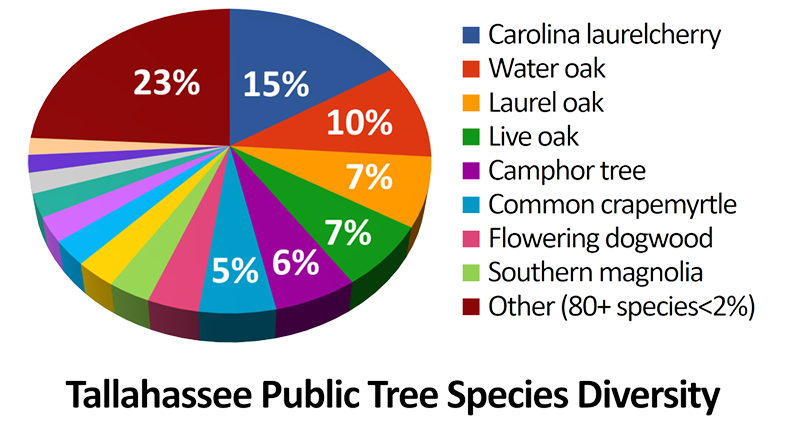
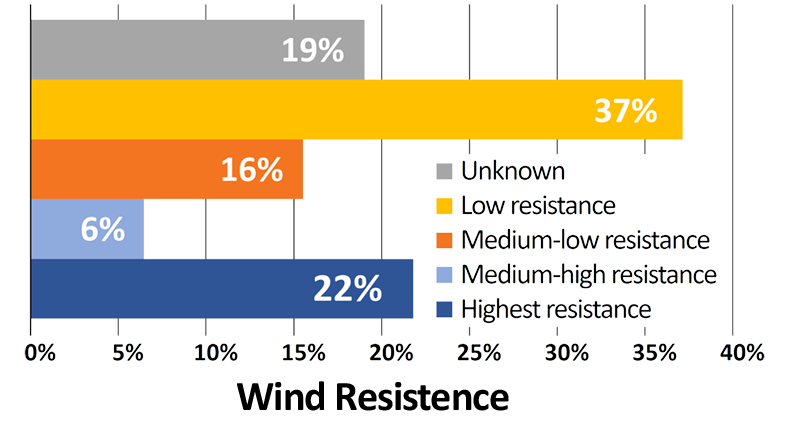
(Credit: University of Florida IFAS Hurricane Recovery Research.)
Similarly, looking at age diversity and condition of trees we see the results of an urban forest with a high proportion of short lived species prone to damage. Young tree population is high, pointing to strong planting programs but also lots of regeneration of species that grow from seed easily. But other categories are under recommended standard. Many of our most common tree types simply don’t live that long, and once they achieve mature size they are typically in decline due to structural issues and decay.
| Tree Condition |
% of Public Trees |
| Good |
3% |
| Fair |
78% |
| Poor |
13% |
| Dead/dying |
4% |
| Unknown |
2% |
| Diameter |
% of Public Trees |
Industry Standard |
| 0" - 8" Young |
67% |
40% |
| 9" - 17" Established |
20% |
30% |
| 18" - 24" Maturing |
7% |
20% |
| Over 24" Mature |
5% |
10% |
Implementation
Complete an Inventory of Public Trees and Transition to Proactive Management
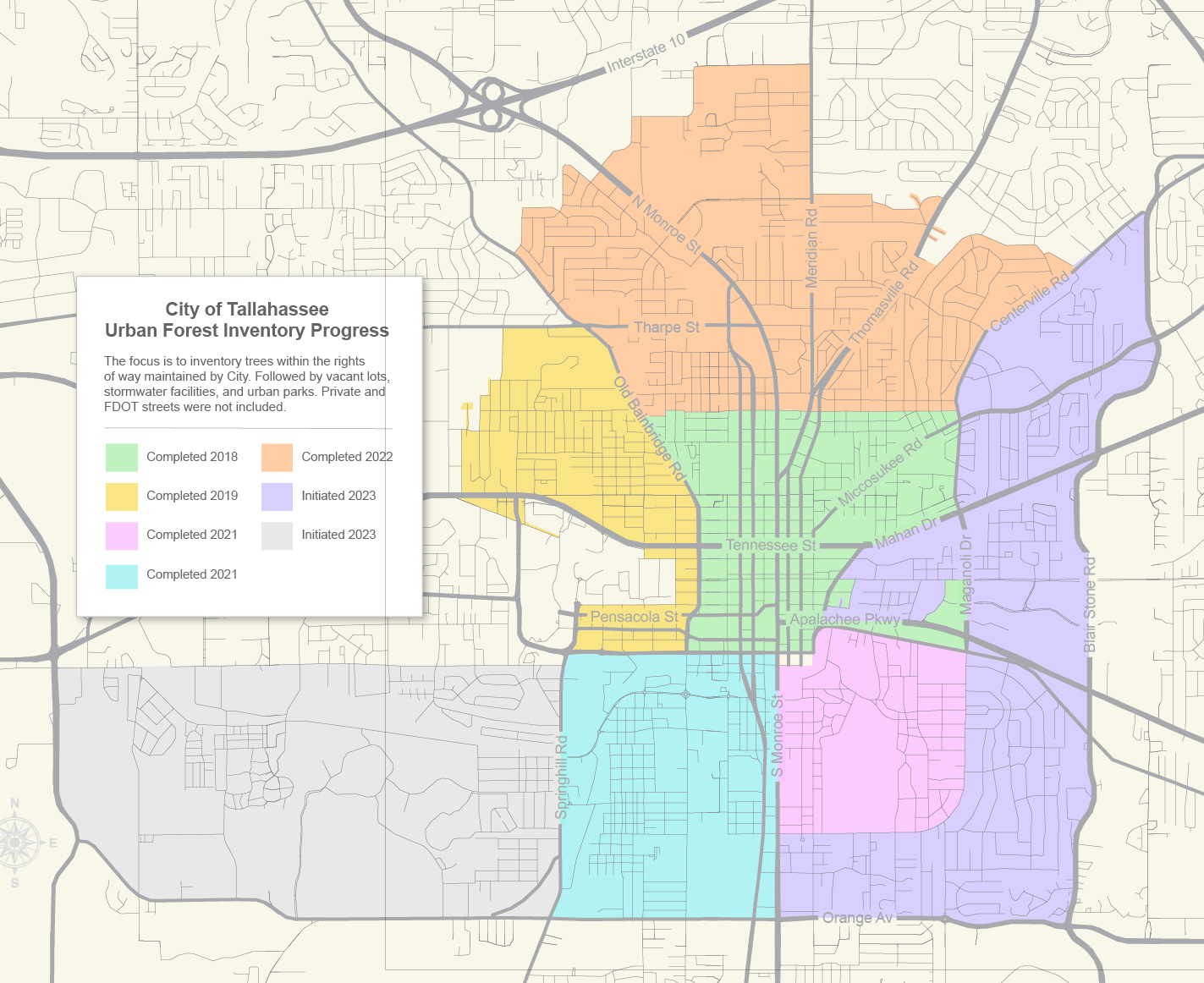
Tree inventories provide valuable information that tree managers can use to plan and budget for maintenance and ensure that planting programs support a diverse and resilient urban forest. The City’s Community Beautification Division is in the process of completing a full public tree inventory (see map image for completed areas)..
- More than 8,700 square acres of inventory data have been collected.
- 2021 Pro-active maintenance recommendations completed.
- 2022 Pro-active maintenance recommendations currently under evaluation.
- The 2023 inventory phase will add an additional 2,600 acres, and is partially funded through an Urban & Community Forestry grant.
- Top five species in areas collected (not representative of entire population): Live Oak (17%), Crepe Myrtle (15%), Water Oak (12%), Sabal Palm (6%), Camphor Tree (4%).
Evaluate and Update Tree Preservation and Planting Regulations
Tree Preservation and Planting Regulations are found in Chapter 5 - Environmental Management of the Land Development Code. These regulations should support the goals of the Urban Forest Master Plan, and several efforts have been completed since acceptance of the plan.
- Tree Matrix: A panel of experts including local Landscape Architects, Horticulturists from local Extension offices, and leaders in the nursery industry met with City forestry and arboricultural staff from Planning, Growth Management, Parks, Community Beautification, Electric Utilities and Public Infrastructure to review and expand recommended tree species, resulting in the creation of a “Tree Matrix” describing allowable species for various uses to ensure planting of “the right tree in the right place.”
- Right Tree Right Place: Planning appropriate space for trees in an urban environment is an ongoing process. Pro-active solutions to minimize conflict between trees and hardscape are in a constant state of improvement. Solutions include using root barriers, alternative pavement materials and design guidelines for spaces that accommodate trees and different uses.
- The City Growth Management Department has a Video Library that includes helpful videos that explain Code regulations and permitting, including the tree regulations. https://www.talgov.com/growth/growth.aspx
- Development Code Analysis: An analysis of past development projects was completed to evaluate the effectiveness of existing development regulations. This included determining pre and post-development tree canopy coverage, diversity, wind resistance, and other factors.
Address the Challenge of Tree Availability at Local Nurseries
During development of the UFMP, a commonly stated challenge was the lack of availability of a wide range of native species at local nurseries. In order to support a healthy, diverse urban forest, a wide variety of species needs to be available to purchase, both in retail and commercially for large planting projects.
- Representatives from the nursery industry and local nurseries were included on the panel that developed the Recommended Tree List, and this list will help increase market demand for lesser-known species.
- City departments routinely contract grow with local nurseries in order to ensure quantities of hard to obtain native pants for public planting projects and programs.
Goal 2: Maintain Canopy Levels
Maintain an extensive tree canopy in balance with growth and and change.
Improvements to the quality of our canopy are necessary in order to continue to enjoy extensive tree canopy into the future, however, even with high populations of less desirable species it is important to emphasize that a dense tree canopy is still a major asset. While we put a focus on recomposition, we should continue to prioritize maintaining a high level of canopy through strong planting programs and development regulations that focus on the right kinds of trees, properly planted.
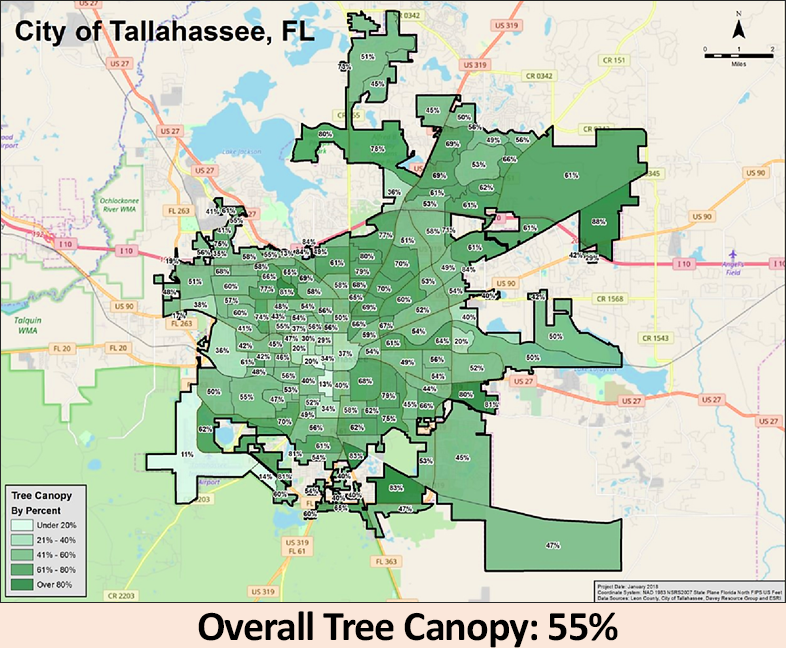
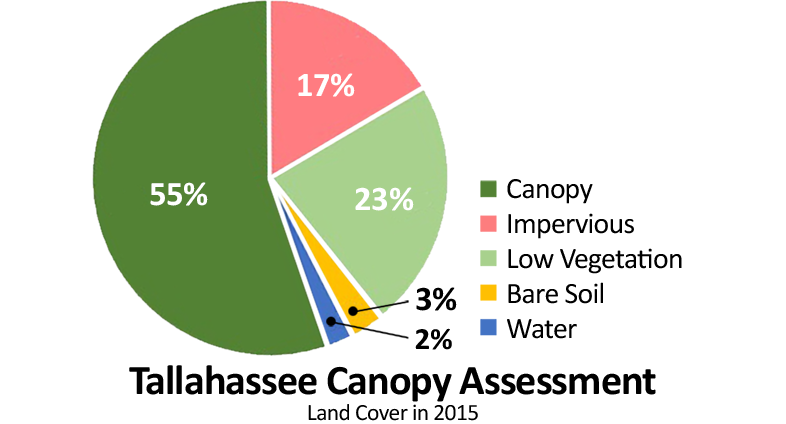
Implementation
Adopt Urban Forest Master Plan and Incorporate into Community Goals
The Urban Forest Master Plan was adopted by City Commission on December 5, 2018.
Encourage Voluntary Tree Planting and Tree Planting on Private Property
The quantity and quality of the City’s tree canopy is extremely dependent on the existence, composition, and longevity of trees on private property, which makes up 70% of Tallahassee’s tree canopy. Providing opportunities for property owners to plant trees and to engage with tree care professionals is very important for the health and sustainability of our urban forest.
Tree Care and Planting in the Public Realm
Trees and landscape are an important part of almost every public project that the city implements. New parks, sidewalks, and roads all have a tree preservation and planting component, and these projects are major opportunities to improve our urban forest through the planting of long-lived, wind resistant native tree species.
- Since adoption of the UFMP, species choices for public planting projects have aligned with the goal to increase the population of the right kinds of tree species. The Recommended Tree List is an important tool that assists staff in choosing the preferred species types.
- Public tree planting has outweighed tree removals. Since 2019, 1,864 public trees have been removed due to poor condition (this does not include invasive species removal and control), and over 4000 trees have been planted in public spaces.
- The 2021 and 2023 Arbor Day events planted over 1200 trees at Governor’s Square Park encompassing over 15 acres of formerly mowed turf grass.
Goal 3: Engage the Larger Community
Engage and partner with the larger community on urban forestry efforts.
Seventy percent of Tallahassee’s urban forest is on private property, so the City cannot do this alone. It is crucial that our community recognizes the value of trees and takes action to plant, preserve, and manage trees to support the community goals.
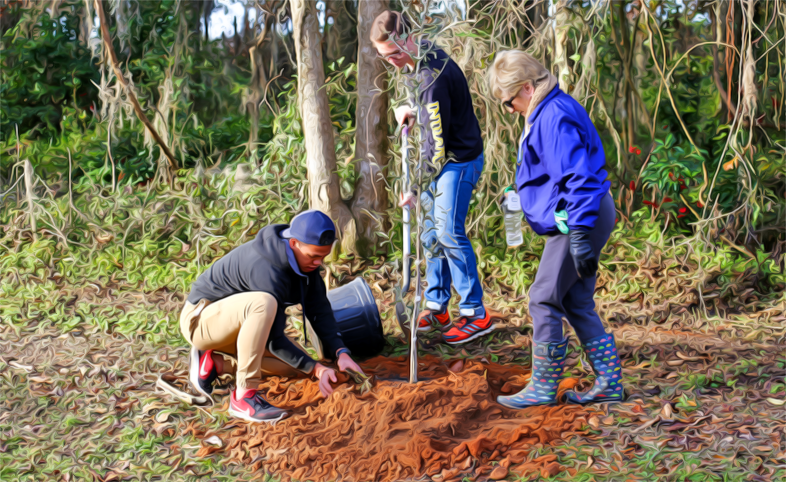
Implementation
Continue to meet with Stakeholder Team
The care and improvement of our urban forest depends on an entire community of professionals and advocates. The Stakeholder team that was established during the development of the plan will continue to work together on plan implementation.
- Team meetings with city forestry and arboricultural staff and stakeholders including local landscape architects, nursery industry, local consulting arborists, and Neighborhood and Homeowners Associations.
- Partnering with community groups is ongoing, for example, Parks, Recreation, and Neighborhood Affairs is partnering with the Apalachee Audubon Society to control invasive species at Lake Elberta Park.
- Planning staff provides guest lectures for FSU’s Environmental Planning classes each semester, introducing a new class of professionals to the concepts of urban forest planning each year.
Outreach, Education, and Public Engagement
- Talgov.com/tallytrees was created as the “hub” for information about Tallahassee’s urban forest. This website will continue to be updated and expanded based on plan implementation and community feedback.
- The Urban Forestry at Home blog, created during the pandemic, is a continuous source of information on tree planting and tree care for homeowners.
- Public education included publication of several articles in the Tallahassee Democrat, American Planning Association Magazine, and presentations for local certified arborists, Big Bend Chapter of the Audubon Society, Tallahassee Garden Club, Society of American Foresters, and Florida Recreation and Park Association.
- Planning staff continues to meet with Neighborhood and Homeowner’s Associations and other interested community groups to speak specifically about the urban forest in their neighborhoods and how residents can be engaged to improve and maintain their trees.
Please contact us if you are interested in learning more about our urban forest! Staff would be happy to attend your organization or HOA meeting to present information and answer questions. Email us at planning@talgov.com.


|